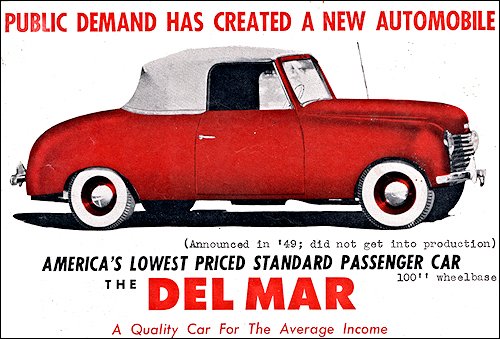Maybe it was the sea breeze and the palm trees. Like the Bobbi-Kar and Town Shopper that came before it, the Del Mar sprung forth from sunny San Diego to make a brief splash in the pool of startup automakers of the 1940s. Like its Southern California cohort, Del Mar’s business plan was long on the ethereal qualities of hype and hope, and lacking in hard tangibles like sufficient working capital…and actual cars. The story would have some international intrigue that the others didn’t have, but the result in the end was the same.
Del Mar (AACA Facebook page/BobCunningham)
The Del Mar made its public debut on Valentine’s Day 1949. The attractively styled 3-seat convertible was appropriately painted red. It was bigger than a Bobbi-Kar or Town Shopper, but still pretty small. It looked a bit like a ’49 Ford in 5/8th scale. The promotional materials were full of promise. The body was touted as being comprised of 11 panels that were formed out of “aircraft aluminum and color infused plastic,” although they didn’t say which parts were of which substance. Power came from a 49hp Continental 4-cyl engine that, teamed with those lightweight materials, should have given a Del Mar fairly sporty performance…had a road test ever been reported. The brochures also advertised it as “the lowest priced standard passenger automobile.” But seeing as its 100-inch wheelbase was 11” shorter than the contemporary short wheelbase Plymouth P-17 - itself 7” shorter than a ‘standard sized’ Plymouth - we are left to wonder about the standard by which the word standard was being measured.
The Del Mar was projected to sell for $1120. That is somewhat above the supposed magic number of $1000. But after three years of post war double digit inflation, it was still 20% less than a Ford Convertible, a car that possessed little in the way of aircraft aluminum or color infused plastic.
Like with those earlier small cars from San Diego, the Del Mar story was pitched as bright and sunny as a day on Mission Bay. In June of 1949, Del Mar’s CEO Arthur Cooksey boldly announced that assembly was underway at a former CONVAIR aircraft factory. This was in fact the same plant that S.A. Williams had leased to build Bobbi-Kars three years earlier, leading some to speculate that Williams may have been an understandably silent partner in the venture. But Cooksey’s goals were even more lofty than Williams’. He would build 600 cars in the next six weeks, and 100,000 by year’s end. Cooksey went on to announce that orders were pouring in so fast that the company was in negotiations for more factory space around the country and even in Europe.
The story on the ground, however, was somewhat more subdued. A visit to the “factory” in late 1949 would have revealed no assembly line at all. Just a couple of guys over in the corner feverishly putting together a second prototype. This car was slightly larger and sleeker than the original, and said to sport a more powerful 63hp Continental engine.
Del Mar (www.MacsMotorCityGarage.com)
Despite his operation beginning to take on an odor evocative of a ham sandwich left out in the Southern California sun too long, Cooksey managed to soldier on a while longer. After the Keller Motor Company gave up the ghost following George Keller’s unfortunate passing, Cooksey was able to step in and acquire the company’s name and assets for $65,000…or at least the promise of such. It was a contingency-laden deal that involved maintaining production at the former Keller factory at the U.S. Army’s Redstone Arsenal in Huntsville, Alabama. This was the same building Bobbi-Kar’s S.A Williams had leased 2 years earlier, before feeing California regulators.
Upon securing this agreement, Cooksey immediately signed another deal, this time with Keller’s former would be European distributor, Roger Delbecq of Brussels, to build a slightly redesigned Keller with a Del Mar-ish looking front end. Belgium being a long way from California, Delbecq did not notice the stench emitting form Del Mar Motors. He showed two cars at the 1950 Brussels auto show to much acclaim. This spurred him on to order engines, transmissions and dies. But Cooksey’s Alabama deal would soon collapse. He proved to be no more capable of getting production up and running in Huntsville - thus maintaining his lease on the plant - than he was in San Diego. By the end of 1950, Del Mar Motors was kaput, Arthur Cooksey was nowhere to be found, and Roger Delbecq was bankrupt.
But the story would take one final twist. In 1953, another Belgian by the name of Poelemans acquired Delbecq’s inventory of Keller parts. He attempted to get the car into production under the PLM and later Pullman name. There were plans to sell 1200 Pullmans in Belgium and the Netherlands, but it is thought that no more than a hand full, if any, were built before this company, too, closed its doors. No Del Mar, PLM or Pullman car, whether it was made in San Diego, Alabama or Belgium, is known to exist today.
Copyright@2020 by Mal Pearson




